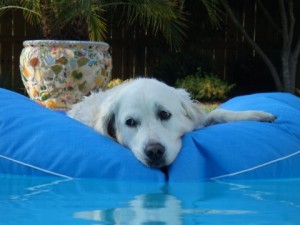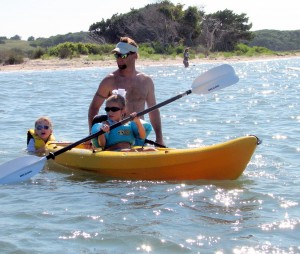
A favorite summer pastime for many of us is relaxing by a pool or swimming in the ocean while unwinding from the day or — better yet — even spending the whole day poolside blissfully relaxed. If your dog is included, here are some tips.
Not all dogs enjoy swimming or can swim particularly well. If it seems like your dog does not want to swim, it is important not to force him/her. A safety vest such the canine flotation device, is designed to keep your pet afloat in the water. These vests are adjustable and designed to fit around your pet’s chest. Having a ramp installed in the pool or around the dock may also help your pet exit the water without struggling.
If your furry family member is an avid swimmer who enjoys a refreshing dip, it is important for you and your children to swim at a safe distance to avoid getting scratched or pulled under while swimming. It is also helpful to teach your dog the “turn” command so he/she can swim around you to avoid those unwanted scratches. When your kids are swimming beside or with your pet, make sure they have on their life vest.
Watch for water-related problems such as ear infections, a dull, dry coat and signs of dehydration. Dehydration can occur quickly — an easy way to check that your dog is not dehydrated is to lift your dog’s lips and look for bright pink and moist gums.
Outdoor exposure to water can change your dog’s vaccination needs. Know your dog’s travel history, disease exposure, age, breed and health status to tailor a vaccination protocol. Pets can contract several contagious water-borne illnesses and intestinal parasites such as Giardia from exposure to outdoor untreated water.
Also, excessive ingestion of heavily chlorinated pool water, saltwater or stagnant lake water can result in vomiting and diarrhea. You might consider bringing plenty of fresh filtered or bottled water to the pool, ocean or lake to avoid intentional ingestion of these and other potentially harmful agents.
Be sure always to have plenty of fresh water available at all times to all pets in the home, year-round. Provide plenty of shade and a cool, dry shelter from the heat and the elements. To avoid burned footpads and heat exhaustion, exercise your pets during the early morning and at dusk when the pavement is cooler and heatstroke is less likely.
 Our classic health insurance plan
Our classic health insurance plan









